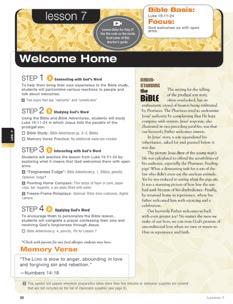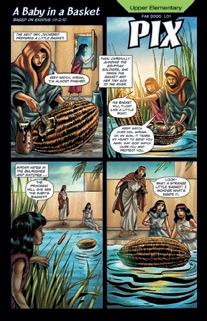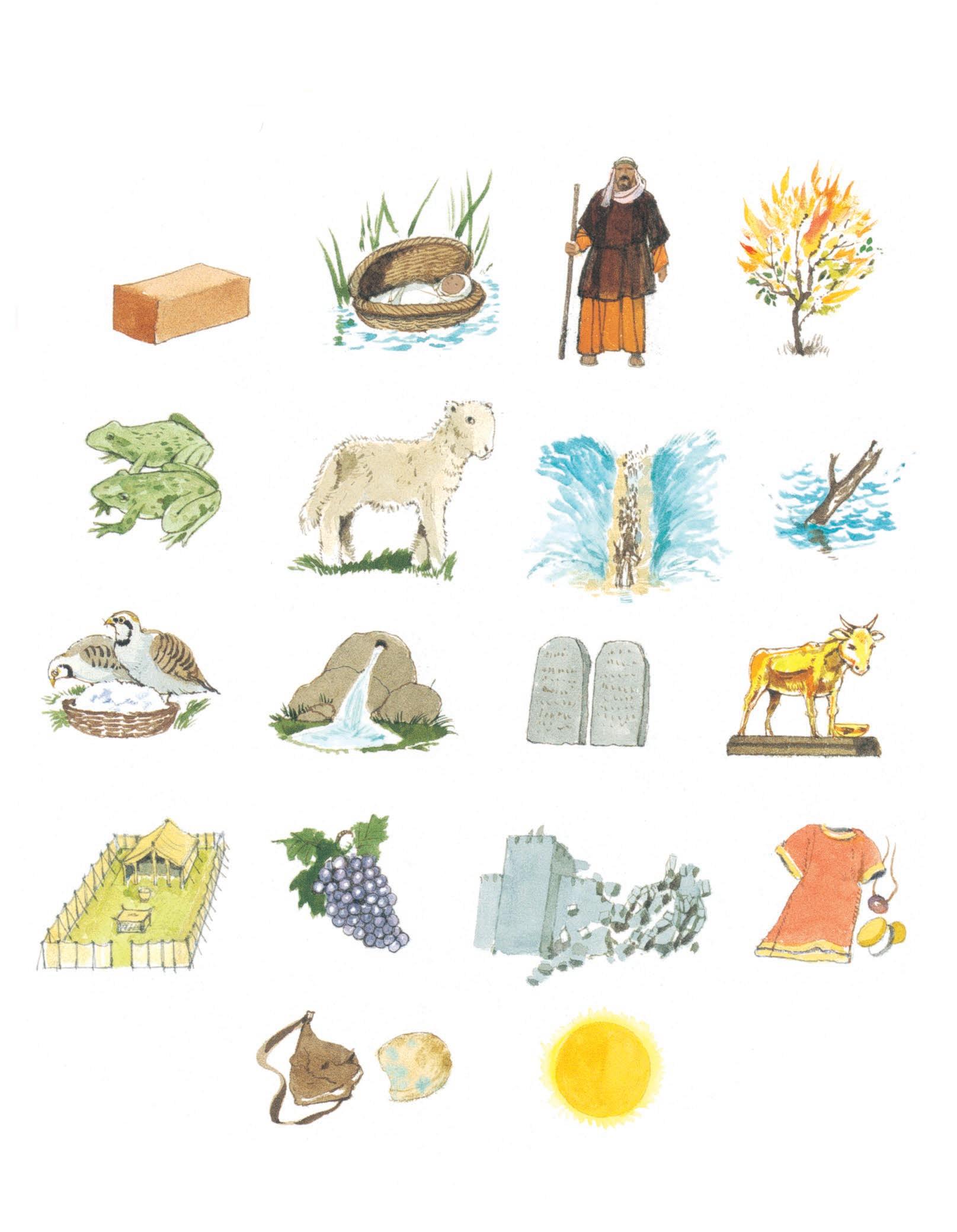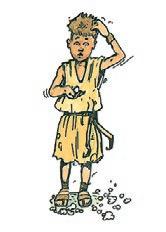
















escaping egypt I god delivers us I following god with courage




Custom-created videos accompany every Bible-in-Life lesson. Right before Step 2, a three-minute video introduces each unit theme. A guide, found with the videos, ties the unit theme to the day’s lesson.
Unit Value: Discernment
Lesson 1
Sept. 7
1:7– 2:15
Lesson 2 A Little Help, Please
Sept. 14
21
Sept. 28
3:1–4:20
3 Don’t Give Up
5:1–10:29
Oct. 12 Exodus 15:23–17:7; Numbers 20:1-13
Oct. 19 Exodus 19:16-25; 20:22-23; 32:1-35
Lesson 8 Where God Lives
Oct. 26 Exodus 25:1–27:21; 40:17-38; Leviticus 9:1-5, 22-24
Lesson 9 Going Against the Crowd
Nov. 2 Numbers 13:1–14:45
Lesson 10 In God We Trust
Nov. 9 Joshua 1:1–6:27
Lesson 11 Escape the Temptation Trap
Nov. 16 Joshua 7:1–8:22
Lesson 12 Get the Scoop
Nov. 23 Joshua 9:1-27
Lesson 13 Impossible Possibilities
Nov. 30 Joshua 10:1-14
Unit family devotions, along with the videos, can be sent to your families to continue learning at home.
You can stream these videos from the site or download them to your own device.
Get the lesson videos at BibleinLife.com/Video
Upper Elementary Teacher’s Guide for grades 4-5. Can also be used for grades 5 & 6 or grades 4-6.
Editor Rebecca Stone
Designer Dale Johnson
To equip the Church with Christ-centered resources for making and teaching disciples who obediently transform today’s generations . . . David C Cook is a nonprofit organization dedicated to international Christian education.
© 2025 David C Cook, 4050 Lee Vance Drive, Colorado Springs, CO, 80918, U.S.A. All rights reserved. Printed in South Korea. May not be reproduced without permission.
All Scripture quotations, unless otherwise indicated, are taken from the Holy Bible, New International Version TM, NIV TM Copyright © 1973, 1978, 1984, 2011 by Biblica, Inc. Used with permission. All rights reserved worldwide. www.biblica.com.
Cover Photo: © Westend61/Getty Images
Contact Us
Visit our website at DavidCCook.org Contact us at 1-800-323-7543 (U.S. only) In Canada visit parasource.com (Canada Only) or 1-800-263-2664 (Canada Only)

Unit 13
Escaping Egypt
These lessons on Moses show how he learned to rely on God’s help to bring His people out of Egypt. As students see Moses’ perseverance and dependence on God, they will be encouraged to trust God’s help for their own lives.
Unit 14
God Delivers Us
In these lessons about Moses and the Israelites journeying to the Promised Land, preteens will see how God remained with them through their hopeless situations and wrong behaviors. Students will find that God also desires to stay by their side through all their ups and downs.
Unit 15
Following God with Courage
These lessons about Joshua turning to God to help him lead shows students that trusting God takes courage. As students see Joshua’s example, they will be challenged to choose courage as they walk with God.



In every lesson, you’ll find a teacher devotional, Bible background information, tips on understanding and teaching upper-elementary students, and the tools needed to guide your students through the Bible study. Also includes a variety of activities to help your students learn and apply the Bible lesson. Need one per class.

PraisePAC features three songs that correlate with each of the three units per quarter along with downloadable lead (song) sheets, lyric sheets, reproducible coloring pages for select upper-elementary lessons, and postcards. Both full and accompaniment versions are available for each song.




This packet equips you with all essential audio and visual resources to go with the teacher’s guide. Packets include PraisePAC, posters, games, 3–D models, puzzles, and more. Need one per class.



This student book, with four pages for each lesson, includes Bible study pages and activities. The cover includes the quarter’s memory verses and a poster or activity. Need one per student.





Pix
Send home these weekly eight-page booklets to reinforce lessons with excerpts from The Action Bible. Pix includes stories, crafts, and more, as well as Faith Forward— lesson-related devotions for preteens and their families. Need one per student.


Each unit features a different video showing children living out their faith in everyday life. These three-to four-minute video segments highlight the monthly unit theme.
There are two downloadable guides to help bring the videos into the lives of your students:
Video Connection Guide: These tie-ins can be used at the beginning of the Step 2 Bible study. Each lesson has a tie-in that connects the theme of the video to the day’s Bible study or lesson focus.
Family Devotions Guide and the lesson videos it connects with are available for the families in your church. Email the guides to families or download them and print them for each unit. Families can use the devotion on its own or also stream that unit’s lesson video to help their family learn and grow together. These devotions are a great way for families to build faith in everyday life!
Lesson videos, video guides, and family devotions guides can be found at BibleinLife.com/video

The Upper Elementary Teacher’s Guide, Upper Elementary Creative Teaching Aids, Bible Adventures, and Pix are also available in a digital format. Need one bundle per class.

FREE! Downloadable Options for Steps 1 and 4
» Relevant subjects (pop culture, trending topics, and fascinating events) that are going on in your students’ world today will help them recognize how God’s Word relates to them here and now.
» Cover topics that students hear and talk about all the time but rarely discuss in Sunday school!
RealLifeDownloaded.com
Find ways to spark your heart and ignite your children’s ministry. Go to MinistrySpark.com and sign up to receive more free resources.
o Upper Elementary Teacher’s Guide (1 per class)
o Upper Elementary Creative Teaching Aids (1 per class)
o Bible Adventures (1 per student)
o Pix (1 per student)
o Bibles
o Balloons
o Butcher paper or newsprint
o Construction paper, scrap paper
o Craft sticks
o Crayons and colored markers
o Game markers, spinner, and coins
o Glue or glue sticks
o Hole punch
o Index cards
o Magazines
o Media player
o Metal brads
o Paper clips
o Paper fasteners
o Pencils with erasers
o Poster board
o Rubber bands
o Scissors
o Soft foam ball, beanbags
o Stapler
o Tape (clear, masking)
o Whiteboard, markers, and erasers
o Yarn, string
See individual lessons for additional supplies needed.
• 2 c. flour
• 1 c. salt
• 4 T. cream of tartar
• 1 pkg. unsweetened dry drink mix for scent and color
• 2 c. warm water
• 2 T. cooking oil
Stir over medium heat until mixture pulls away from sides to form a ball.
Store in airtight container. (For eight to ten children.)

Bible-in-Life’s four-step plan is designed to make lessons easy to teach. Each step engages teachers and students to learn more about God and connect those findings to everyday life.
Connecting with God’s Word helps preteens relate their own experience to the Bible study. With a short activity and discussion, this step gives your students time to share about themselves and their lives while building relationships with you and one another. For an option that uses current topics and issues for this step, go to RealLifeDownloaded. com. These conversations will flow naturally into Step 2: Studying God’s Word.
Studying God’s Word uses the Bible and Bible Adventures as students explore God’s Word together. Your class will dive into a portion of God’s Word, work on understanding what they’ve read, and begin to connect it to their lives. Your class will also have an opportunity to learn the lesson’s memory verse.
Interacting with God’s Word allows students to practice, review, and explore the Bible lesson. Exploring the Bible study at their own level helps preteens understand and incorporate God’s Word into their day-to-day lives.
Bible Response helps students apply the lesson into their everyday lives. Students choose the best way to live out their faith in their daily experiences so they can be doers of the Word, not just hearers. If you used Real Life Downloaded in Step 1, use the correlating Step 4 here.
by Leura Jones
What could be more wonderful than the God who created the heavens and earth also being the one who numbers the very hairs on our heads?
“The whole earth is filled with awe at your wonders,” declares Psalm 65:8, and we get to invite kids into that sense of awe. We can do that through the Bible lessons we teach, the prayers we pray, and the words we use as we talk to kids about their lives and the God who made them.
WONDER IN SCRIPTURE
As we share Bible stories with kids, we can ask them, “What do you think that looked like? How do you think God’s people felt? What would you have been thinking if you were there?” Piquing kids’ curiosity is a great way to spark wonder in their minds.
WONDER IN PRAYER
When we pray with kids, we can communicate wonder and amazement. Psalm 145:4 shows how to commend God’s “mighty acts” to the next generation. The words we use in prayer can do that. It can be as simple as starting with, “Great and mighty God, we are amazed by You.” We may need to keep our prayers simpler as we pray with children, but that doesn’t mean our prayers can’t be big and bold and filled with wonder.
WONDER IN OUR WORDS
As we talk with kids and they tell us about their lives and share their stories, the words we use can tap into their sense of wonder:
“Wow, just think about how much God loves you! Think about all He’s done for you!”
“Can you believe God had a purpose for your life before you were even born?”
“Isn’t it amazing the way God sees you and cares about you?”
THE WONDERS THAT THEY ARE
Every child is a wonder, and every child is naturally filled with wonder. Let’s remind ourselves to see them that way. And let’s be intentional about tapping into their ready sense of awe and wonder as we help to develop and deepen their faith in God.
Exodus 1:7—2:15
God wants us to do things His way.
To help preteens link their experiences about following directions to the Lesson Focus, they’ll participate in a quiz and a discussion about the need to follow directions.
□ Copies of Teaching Aid 3 (from Upper Elementary Creative Teaching Aids)— prepare before class, one for each student; pencils or pens
Using the Bible and Bible Adventures , students will study Exodus 1:7—2:15, in which Moses takes matters into his own hands rather than doing things God’s way.
□ Bible Study: Bible Adventures Lesson 1 pp. 2–3, Bibles, Teaching Aids 1, 2 (from Upper Elementary Creative Teaching Aids ), glue stick or tape
□ Memory Verse Practice: Paper, markers or colored pencils
Students will reinforce the lesson from Exodus 1:7—2:15 by exploring what it means to do things God’s way.
□ Letter from Moses: Bible Adventures Lesson 1 p. 1, pencils
□ Key Verse Puzzle: Bible Adventures Lesson 1 p. 4, pencils
□ Pharaoh’s Command: No materials needed
To help students apply the lesson to their everyday lives, they will choose a situation they’ll face in the next week in which they will do things God’s way.
□ Copies of Teaching Aid 3 (from Upper Elementary Creative Teaching Aids) used in Step 1, Bibles, pencils, markers, Cover wrap from Bible Adventures, Pix for Lesson 1
“My thoughts are not your thoughts, neither are your ways my ways,” declares the L ord
—Isaiah 55:8
Genesis ends with the death of Joseph in Egypt. Many years passed until a pharaoh who did not remember Joseph or his contribution to Egypt came to power. This new pharaoh, believed by some scholars to be Ahmose, founder of the 18th dynasty, was afraid of the Hebrews, so he enslaved them and forced them to build his great cities. The pharaoh’s building program required many bricks, so the Hebrews were often forced to make the bricks they used to complete their tasks.
Understandably, the Hebrews were unhappy with their status in Egypt, and God heard their cries of anguish. He raised up a leader— Moses—to lead them back to the land He had promised them.
The Jewish historian Josephus says that an Egyptian seer, or prophet, told the pharaoh that a child who would crush Egypt and raise his own nation to power was about to rise among the Hebrews. Pharaoh may have felt threatened by this prophecy and thus ordered the deaths of male Hebrew babies that are recorded in Exodus 1:22.
The Hebrew word for the “papyrus basket” used to save Moses (Ex. 2:3), interestingly, appears only one other time in Scripture: It is the same word used for Noah’s ark (Gen. 6:14). Both of these floating “rescuers” were also coated with pitch to make them waterproof.
Moses was already 40 years old when he killed the Egyptian overseer and fled to Midian. Moses learned a lesson the hard way. When God calls us to do something, it’s best to wait for His leading and timing.
This symbol will appear whenever preparation takes more than five minutes or whenever supplies are needed that are not included on the list of classroom supplies (see page 6).



Why don’t you just stop and ask directions?”
“No, no. I know where I’m going.” Does this sound familiar to you? How much aimless wandering could we avoid if we would just take the time to learn and then follow directions!
God has given us directions, too—in His Word, in the godly counsel of other believers—but sometimes His path doesn’t seem quite clear, or His plan is surprisingly different from what we would choose for ourselves. But while God doesn’t always think the way we do, His plan is always the best because He is all-knowing and all-wise, and we would do well to willingly follow His plan.
Read today’s memory verse, Isaiah 55:8. Take some time to write down an instance from your own experience when going against God’s plan led to problems or failure.
Now think of a time when following God’s way led to blessing or success.
Moses is admired for his willingness to follow God’s plan to lead His people out of slavery. But even Moses took a detour or two from following God’s directions, as this lesson will show. As you prepare to teach this lesson, pray that you and your students will be reminded, from this account of Moses’ failure to follow God’s directions, of the benefits and blessings of doing things God’s way.
Your upper-elementary students are beginning to spread their wings of independence a bit more, so any help they can get in making good choices is very valuable. This week’s lesson provides a baseline value for this age group, even though some may already struggle against doing things someone else’s way.
• Some fourth and fifth graders demonstrate a “know-it-all” attitude, often as a bluff for their weak self-confidence. Don’t be offended by their disposition; understand its part in their quest for independence.
• Others in this age category, particularly the younger ones, will clearly show their uncertainty about their ability to make good choices. Build a
Use these suggested activities for preteens who arrive early for class. Which Way? - Bring in a street map of your city or use a map app. Have students write out directions from their home to another place, such as your church. Students may wish to exchange their directions to see if others can follow them.
Easy as Pie - On 3-by-5-inch note cards, write out the steps needed for baking a pie—one step on each card. Throw in a few steps that don’t belong. Using masking tape, put the cards in random order on the wall. Allow students to try to get the steps in the proper order.

strong faith foundation by encouraging preteens to find help in God’s Word whenever a situation offers the chance.
• You also may have some students who sincerely desire to do things God’s way.
Celebrate it! Affirm their interest in spiritual things and help them in their individual seeking for God. Offer other resources to strengthen their Bible knowledge and be attentive to their spiritual journey.
• Get to know your students better by asking questions about their lives outside class, and learn to listen carefully and with interest. You’ll help them find God’s way as you gain their trust and know them beyond the superficial.
Connecting with God’s Word
Focus:
God wants us to do things His way.
To help preteens link their experiences about following directions to the Lesson Focus, they’ll participate in a quiz and a discussion about the need to follow directions.
Start your class with a lighthearted, mock quiz to show them the importance of following directions. It’s okay to create a tiny bit of test anxiety as you hand out the papers.
Materials:
□ copies of Teaching Aid 3—prepare before class, one for each student □ pencils or pens
We’re off to a new school year, so let’s see how well you can follow directions. Don’t worry, this won’t be graded! But please do your very best. You will only have three minutes to complete this quiz!

Give each student a copy of Teaching Aid 3. After making sure everyone has a pen or pencil, tell students they may begin. Announce the time remaining at one-minute intervals if students are still working. Then, when the time is up, have students gather together for a discussion.
➲ Have you ever taken a quiz like this before? Tell us a little about that.
➲ What do you think is the purpose of this quiz?
➲ How are directions important in our everyday lives?
➲ Who usually gives you directions? (Teachers, doctors, parents, day-care providers, etc.)
➲ What kinds of things do we need directions for? (How to do homework; how much medicine to take and when to take it; how to get somewhere that we’ve never been; how to make cookies)
➲ What are some of the things that might happen if we don’t follow directions? (People might get more sick from taking medicine incorrectly; cookies might burn or flop in some other way; we might get a bad grade on an assignment; or you could have a perfect assignment, but the teacher doesn’t know it’s yours because your name isn’t on it)
Today’s Bible topic is all about doing things God’s way, not our way. In other words, we are to follow God’s directions for us, both in how we think, and in how we act. Today’s lesson tells us some of the story of Moses. Moses was a great leader of the Israelites, but that doesn’t mean he always followed God’s directions. Let’s find out what happened when Moses thought he could make decisions without first asking what God wanted him to do.
Studying God’s Word
Bible Basis:
Exodus 1:7—2:15


Using the Bible and Bible Adventures, students will study Exodus 1:7–2:15, in which Moses takes matters into his own hands rather than doing things God’s way.
Materials:
□ Bible Adventures , pp. 2–3 □ Bibles □ Teaching Aids 1, 2 □ glue stick or tape
Give your students a copy of Bible Adventures Lesson 1. Have students turn to the Bible study found on pages 2 and 3, “I’ll Do It My Way!” Also ask your students to locate and bookmark Exodus 1 and Acts 7:23 in their Bibles.
Since this is a new quarter and a new school year, you will want to take a moment to explain the features in the Bible Adventures study pages. Point out the footnotes that help with pronunciation and give additional facts about the study. The Scripture Spotlight features key passages from the Bible Basis. In addition, your students will look up Scripture in their own Bibles at various points in the lesson.
Have students read the introductory paragraph of the Bible study to themselves. Point to the land of Egypt on Teaching Aid 1 and have a student add Figure 1A (from Teaching Aid 2) to the area of Rameses. Then choose a student to read Exodus 1:15-17 from the Bible before discussing the following questions.
➲ What did Pharaoh order the midwives to do? (Kill the Hebrew boys when they were born.)
➲ Why didn’t Shiphrah and Puah obey Pharaoh? (Because they feared God.)
Ask another student to read Exodus 1:20-21 from the Bible, while the others follow along.

“My thoughts are not your thoughts, neither are your ways my ways,” declares the L ord —Isaiah 55:8
□ paper, markers or colored pencils
Egyptians were known for their hieroglyphics, or picture writing. Let students make their own hieroglyphics with today’s memory verse. Students can work alone or in groups. When they are finished, have them trade papers to decipher the verse.
➲ What happened to the midwives because they obeyed God? (God was kind to them. He blessed them with families of their own.)
Ask for a volunteer to read the first Scripture Spotlight (Ex. 1:22; 2:1-3) from Bible Adventures. Have a student add Figure 1B (from Teaching Aid 2) next to Figure 1A.
➲ Was it right for the midwives and the mother to disobey Pharaoh? Why? (Let your students wrestle with this question for a moment. Help them see that it was right for the midwives to disobey Pharaoh because we need to obey God’s directions above all others. God’s directions will not lead us down a wrong path. God is always right.)
➲ What did Pharaoh do next? (Pharaoh ordered that every boy baby be killed, while girl babies were allowed to live.)
Some students may point out that something very similar happened many years later when Jesus was born. King Herod ordered that all boys two years and younger in the Bethlehem area be killed (Matt. 2:16). It was because of this event and the danger from King Herod that Jesus was taken to Egypt by Mary and Joseph.
Ask for another volunteer to read the second Scripture Spotlight (Ex. 2:11-14).
➲ What did Moses do to the Egyptian who was beating the Hebrew? (Killed him and hid his body in the sand.)
➲ Why do you think Moses did this? (Allow for speculation. Remind students that Moses was concerned with the Hebrew people and wanted to help out. He probably felt angry and frustrated. He was trying to take matters into his own hands.)
➲ How old was Moses when this happened? (He had grown up; he was an adult.)
Ask a student to read Acts 7:23 while the others follow along. This verse tells us that Moses was 40 years old at this time.
➲ What did Moses do the next day? (Moses tried to stop two Hebrews from fighting.)
➲ Who was Moses trusting in? Why? (He was trusting in himself, because he didn’t know God’s directions. He tried to take matters into his own hands instead of trusting God to take care of them. Point out that sometimes we act without thinking, or we think it's easier to do things our own way.)
Ask a student to read the concluding paragraph.
➲ How does our Lesson Focus—“God wants us to do things His way”— relate to today’s Bible study? (Moses felt the consequences of not following God’s way when he killed the Egyptian.)
Interacting with God’s Word
Students will reinforce the lesson from Exodus 1:7–2:15 by exploring what it means to do things God’s way.
In today’s Bible study from Exodus 1:7–2:15, students were introduced to Moses and saw how he did things his way rather than God’s way. Each of the activities below will help your students reinforce the lesson in a different way. Use as many of these choices as you can, letting students choose freely among them.
□ Bible Adventures , p. 1 □ pencils
Students can review the events of the Bible study in a letter format. Tell your students to look at the letter on page 1 of Bible Adventures. Ask them to pretend they are Moses and complete the blanks on the letter. When they have finished, they may read their letters to each other and discuss their responses.
➲ How can Moses’ experiences help you as you try to do things God’s way?

□ Bible Adventures , p. 4 □ pencils
To help your students check their knowledge of today’s memory verse, Isaiah 55:8, let them complete page 4 of Bible Adventures, “His Way or My Way?” This challenging color-coded puzzle supplies some words of the verse, but students must follow the colored lines to discover the missing words. Students can work individually or in pairs to solve the puzzle.
➲ How does the Bible verse go along with doing things God’s way?

Materials: none
During this activity, preteens will use what they know about ancient Egypt while following directions in a fun, active way. If your students have recently studied Egypt, they might wish to add actions of their own. Choose one student to be Pharaoh; everyone else will be an Egyptian. Pharaoh directs the Egyptians by telling them what action to do. The last student or group to do the action is out. The last Egyptian in the game becomes the new Pharaoh. Actions Egyptians can do include: pyramid—groups of three form a pyramid*, mummy— lay on the floor with arms crossed, camel—one student kneels on the floor and another student stands over him as if he’s riding the camel, hieroglyphics—pretend to draw hieroglyphics on the wall.
➲ How do you see God’s way happening in Egypt through today’s Bible study?
*In forming a pyramid, students should not climb on another student; instead, students should form a pyramid with two students kneeling and one standing.
When the time you have allotted is up, ask your students to clean up the materials and gather back together.
Applying God’s Word
God wants us to do things His way.


To help students apply the lesson to their everyday lives, they will choose a situation they’ll face in the next week in which they will do things God’s way.
Materials:
□ copies of Teaching Aid 3—used in Step 1
□ Bibles
□ pencils
□ markers
Moses was 40 years old when he killed the Egyptian. As we’ve learned, he definitely wasn’t following God’s way when he committed this crime. If he had trusted in God to give him guidance, he would not have killed the man. Even though you are not nearly as old as Moses, you are like Moses in one important way. You can make choices whether to follow God’s way or your own way.
We have choices every day. We can live the amazing, original, one-of-a kind life God has planned for us. This week there’s probably some situation in which you can choose your way or God’s way. Whether we want to admit it or not, when we face a choice, we are wisest when we remember that God wants us to do things His way.
As a class, brainstorm different choices and situations your preteens will face during the week. On the back of the quiz from Step 1, have each student write down several ideas of when they will ask for help in doing things God’s way next week (sitting with someone at lunch who appears lonely; doing a chore before being asked; sending someone a note to encourage or cheer them; walking away when tempted to fight with a sibling). Then have them creatively write the memory verse, Isaiah 55:8, under their ideas to remind them that God will help them follow His way.
Spend some time discussing their answers. End in prayer asking for God’s help to follow His way in the specific areas students mentioned.
Send home the Cover wrap of Bible Adventures. Point out how it is a movie poster of today’s lesson.
Seeing God throughout the Week:
Encourage your students to make a choice this week to follow God’s way. Talk about how we can ask God for help when we want to do things our own way.
Pop Quiz, Lesson 1 and Cover wrap of Bible Adventures , Lesson 1 of Pix
Use this game to give students more practice with following directions. One person takes the role of direction giver while the others stand at one end of the room and close their eyes. The direction giver finds a spot in the room and gives the best directions he or she can so that the others can reach this predetermined destination (under a table, at the door, etc.). Examples of directions: take three steps forward, turn to your left and move ahead two long steps, get on all fours and crawl as far as you can, back up until I say stop.

Fourth and fifth graders are capable of understanding and responding to God’s plan of salvation. Although some cannot understand the abstract concept of faith, they can grasp the following:
» They can see the moral reasoning of Bible characters and God’s response to their actions.
» They are beginning to understand ethical concepts—they often have a strict moral code of behavior.
» They are learning how to read and study the Bible with an emphasis on Bible facts.
» They have group values. They want to be part of a church family and Sunday school.
» They understand the purpose of prayer and may make up spontaneous prayers.
Understanding your fourth and fifth graders’ spiritual maturity will help you approach the topic of salvation. Remember, spiritual maturity may or may not follow physical or mental growth. As you interact with your kids, try to notice actions that indicate spiritual yearnings.
One lesson each quarter will specifically focus on salvation, but during any lesson, a child may feel God’s special love and want to respond and accept Christ. For those who do express a special interest, try to talk with them after class. Involve parents by informing them of the situation.
Here’s one way to present the plan of salvation to your kids:
1. Our Sin. Read or have your kids read Romans 3:23 and 6:23. (When possible, use an easy-to-read Bible translation.) Help your kids identify with these verses.
2. Christ’s Love. Read John 3:16 and Romans 5:8. Your kids need to see that Jesus loves them and died for their sins.
3. Our Faith. Read Romans 10:9 and 1 John 1:9. Explain to your kids that Jesus died for our sins and when we believe in Him, Jesus comes into our lives. Lead the kids in a simple prayer, giving them an opportunity to make a commitment to Christ.

God’s Plan
Through the stories of Gideon and Jesus’ birth, students will have the opportunity to learn how to depend on God’s plan.
Scripture: Judges, Matthew, and Luke. Value: Dependability
Who Jesus Is
This unit teaches about who Jesus is and His care for His people.
Scripture: John and Galatians. Value: Compassion
What Jesus Said
Lessons on Jesus’ parables teach preteens the importance of loving God and loving others.
Scripture: Matthew. Value: Love
Every page of these bestselling Action Bible products sparks excitement in kids to explore God’s Word and know Him personally.




A Year’s Worth of Devotionals and Activities for Kids

Purchase your copies at DavidCCook.org or wherever books are sold












How to get your PraisePAC Resources: For best results, download PraisePAC resources to a desktop computer. Go to http://Lesson-DL.com
This Quarter’s Access Code: 202110519
*While it is possible to download a .ZIP compressed file to a mobile device, you may need to install a helper App first, like UnZip or WinZip. Check the Apple App Store (iOS) or the Google Play Store (Android) for a suitable app. Search for “Zip file opener.”
UPPER ELEMENTARY CREATIVE TEACHING AIDS is published quarterly by David C Cook, DavidCCook.org. © 2025 by David C Cook, 4050 Lee Vance Drive, Colorado Springs, CO 80918, U.S.A. Bible In Life and David C Cook and its related logos are registered trademarks of David C Cook. All rights reserved. ISBN 978-0-781-44600-6 #1105125. Printed in Gunpo-si, Gyeonggi-do, South Korea, February–April 2025. All Scripture quotations, unless otherwise indicated, are taken from the Holy Bible, New International Version®, NIV® Copyright © 1973, 1978, 1984, 2011 by Biblica, Inc.® Used by permission. All rights reserved worldwide.
Bible Illustrators: Tony Morris, Joe Van Severen, Richard Williams. Other Illustrators: Jeff Carnehl, Jim Engel, Marcus Hamilton, Joyce John, Dennis Jones, Shannon Mooney, Donna Nelson, Jim Paillot, Ed Sobieraj, Paul Turnbaugh
Cover Photo: © Westend61/Getty Images


Use tape or a glue stick to add the figures to the maps.
Directions: Please do not speak or ask any questions while anyone is working on this quiz. Keep your eyes on your own papers. When you have finished, sit quietly until everyone has finished.
1. Read every instruction before you do anything.
2. Proceed carefully and cautiously.
3. Write your name in the space provided.
4. Draw a picture of your favorite barnyard animal.
5. Cover your mouth with your left hand if you are right-handed and with your right hand if you are left-handed.
6. Print the word “Bible” in the upper right-hand corner of this page.
7. Tug on your left earlobe.
8. Put the name “Moses” in the lower right-hand corner of this page.
9. Write down the name of your favorite food.
10. Nod your head “yes.”
11. On the reverse side of this page, write the names of any three books of the Bible.
12. Circle the book of the Bible that has the most letters in its name.
13. Draw a triangle around the circle you just drew.
14. Touch your forehead with your right index finger.
15. Snap the fingers of your left hand.
16. If you think you have followed these directions, write “I have” at the bottom of this page.
17. On the reverse side of this page, write the word “wink.”
18. Draw an eye shape around the word “wink,” and then add eyelashes.
19. Shut your eyes for three seconds.
20. Please ignore instructions four through nineteen. Follow the instructions in sentence three, and hand in your quiz.
2025




After Moses ran away to Midian, he probably had time to think about what happened. If he decided to write a letter to tell you all about it, what might he have said? Fill in the blanks in the letter below. Tell the story the way Moses might have.
Dear : [your name]
You won’t believe what I did! A few days ago, I saw an Egyptian __________________________________________________________.
I was so angry __________________________________________________________.
The next day I saw __________________________________________.
When I tried to stop them, one said ____________________________ __________________________________________________________.
I got so scared I _____________________________________________ __________________________________________________________.
I was wrong because I ________________________________________ instead of following God’s directions. The next time I try to do things my own way, I’ll __________________________________________________.
Good-bye for now, Moses

1Egyptians called their kings pharaohs. Many people believed the pharaohs were gods.
Pharaoh1 decided to make slaves of the Hebrews. They had to work very hard making bricks to build Pharaoh’s cities. The slave drivers were mean and often beat them. But the Hebrew people kept growing in numbers.
Read Exodus 1:15-17. What did Pharaoh order the midwives2 to do? Why didn’t Shiphrah and Puah3 obey Pharaoh?
him no longer, she got a papyrus basket for him and coated it with tar and pitch. Then she placed the child in it and put it among the reeds along the bank of the Nile.
Was it right for the midwives and the mother to disobey Pharaoh? Why?
2Midwives were like nurses. They helped mothers give birth to their babies.
3Pronounced SHIF-rah and PEW-ah.
Exodus 1:22; 2:1-3, 11-14
Then Pharaoh gave this order to all his people: “Every Hebrew boy that is born you must throw into the Nile, but let every girl live.”
Now a man of the tribe of Levi married a Levite woman, and she became pregnant and gave birth to a son. When she saw that he was a fine child, she hid him for three months. But when she could hide
One day, after Moses4 had grown up, he went out to where his own people were and watched them at their hard labor. He saw an Egyptian beating a Hebrew, one of his own people. Looking this way and that and seeing no one, he killed the Egyptian and hid him in the sand. The next day he went out and saw two Hebrews fighting. He asked
4The name Moses sounds like the Hebrew words for “draw out,” referring to the way he’d been drawn out of the river.

the one in the wrong, “Why are you hitting your fellow Hebrew?”
The man said, “Who made you ruler and judge over us? Are you thinking of killing me as you killed the Egyptian?” Then Moses was afraid and thought, “What I did must have become known.”
What did Moses do to the Egyptian who was beating the Hebrew? What did Moses do the next day? Who was Moses trusting in? Why?

When Pharaoh heard what Moses did, he tried to kill him. Moses had to run away to Midian.5
5Pronounced MID-ee-un. The country was named after Midian, a son born to Abraham and his new wife after Sarah died.
How well do you know today’s Key Verse? Let’s find out! At the bottom of the page, each missing word from the verse has a different color. For each word, start at the dot that is the same color as the word blanks. To fill in the blanks, follow the lines that have the same color. Letters can be used more than once, and you may need to backtrack several times to complete some words. We have given you the very first letter—“M.”















LESSON 7
“Worship the Lord your God and serve him only.” Luke 4:8
LESSON 1
“My thoughts are not your thoughts, neither are your ways my ways,” declares the Lord. Isaiah 55:8


LESSON 2
[The Lord said,] “I will help you speak and will teach you what to say.”
Exodus 4:12
LESSON 3
“Blessed is the one who perseveres under trial.”
James 1:12


LESSON 4
“God is not human, that he should lie, not a human being, that he should change his mind. Does he speak and then not act? Does he promise and not fulfill?”
Numbers 23:19
LESSON 5
“Now faith is confidence in what we hope for and assurance about what we do not see.” Hebrews 11:1


LESSON 6
“Those who are wayward in spirit will gain understanding; those who complain will accept instruction.”


LESSON 8
“Christ may dwell in your hearts through faith.” Ephesians 3:17
LESSON 9
“Choose for yourselves this day whom you will serve.” Joshua 24:15


“Be strong and courageous. Do not be afraid; do not be discouraged, for the Lord your God will be with you wherever you go.” Joshua 1:9 LESSON 10
LESSON 11

“God is faithful; he will not let you be tempted beyond what you can bear. But when you are tempted, he will also provide a way out so that you can endure it.” 1 Corinthians 10:13

LESSON 12
“Blessed are those who keep his statutes and seek him with all their heart.” Psalm 119:2
LESSON 13
“With God all things are possible.” Matthew 19:26

New International Version®, NIV® Copyright © 1973, 1978, 1984, 2011 by Biblica, Inc.® Used by permission. All rights reserved worldwide. Bible Illustrations: Richard Williams; Footnote Art: Joe Van Severen; Cover 1 Photo: © Westend61/Getty Images; Covers 2 and 3 Art: Joe Van Severen. Other Illustrations: Steve Björkman, L. 10, p. 1; Ron Chironna, L. 13, p. 1; Bill Duca, L. 2, p. 4; L. 7, p.
based on exodus 1:1–2:10

The next day, Jochebed prepares a little basket.
Keep watch, Miriam, I’m almost finished.
Then, carefully avoiding the egyptian soldiers, she takes the basket and her tiny son to the river.
his basket will float like a little boat!
keep watch over him, miriam. oh my son, it tears my heart to send you away. may god watch over you and protect you.
Miriam hides in the bulrushes and watches ...
The princess! will she see the baby’s basket?
Look— what a strange little basket! I wonder what’s inside it.
thE MaiD bRingS THe BAsKEt TO the PriNCESs, wHo OpenS iT.
thE MaiD bRingS THe BAsKEt TO the PriNCESs, wHo OpenS iT.

a hebrEW BAby! listen To Him CRY! wE haVe tO FiNd SoMEOne To fEeD ANd carE FOR Him.
a hebrEW BAby! listen To Him CRY! wE haVe tO FiNd SoMEOne To fEeD ANd carE FOR Him.
jUST then, MiRiAm sTEPS Out of THe BUshES.
sHAlL I FiNd a hebREw nurSe fOR tHE BAbY?
sHAlL I FiNd a hebREw nurSe fOR tHE BAbY?
yEs. BRinG one To ME aS sOoN AS YOU can.
yEs. BRinG one To ME aS sOoN AS YOU can.
jUST then, MiRiAm sTEPS Out of THe BUshES. at ThE River’s EDGe…
at ThE River’s EDGe…
mothEr!
COMe RiGHT AwaY. thE PriNcesS HAs found OUR baBy — AND ShE WanTs A HebrEw NuRSe to TaKE CAre OF him.
mothEr! COMe RiGHT AwaY. thE PriNcesS HAs found OUR baBy — AND ShE WanTs A HebrEw NuRSe to TaKE CAre OF him.
gOd has AnSWerED mY pRayer, MiRiAm. MY soN wilL BE Safe WiTH thE PrincesS.
gOd has AnSWerED mY pRayer, MiRiAm. MY soN wilL BE Safe WiTH thE PrincesS.
tAke THiS baBy ANd carE FoR him. if AnYONe qUEstionS yOu, seND Word TO ME at onCe.
tAke THiS baBy ANd carE FoR him. if AnYONe qUEstionS yOu, seND Word TO ME at onCe. I’m naming him moses, because i pu ed him out of the water.
I’m naming him moses, because i pu ed him out of the water.
based on exodus 2; acts 7:22-29
So the hebrew baby is returned to his own home—but now under the protection of the king’s daughter. That night, amram and jochebed gather moses with his sister, miriam, and brother, aaron. They kneel and pray.
young moses lives in his home until he is about four years old. then his mother takes him to the palace to live with the princess, who adopts him.

o God, we thank you for saving our little son. help us to train him to serve you.
years pass, and the boy moses lives the life of a young prince in pharaoh’s palace. one day he drives through the city ...
... To a place where hebrew slaves are working. as he watches the slaves toil, he is startled by a man’s scream ...
moses jumps from his chariot to investigate—and finds an egyptian guard beating a hebrew slave.

i n sudden anger, moses strikes out hard ...
Look! he killed the guard!
The next day Moses returns. When he s s two Hebrews fighting, he tries to stop them.
People know I have ki ed a man. There’s only one thing I can do, and I have to do it now! Don’t fight each other!
Who made you a judge over us? Are you going to ki me the way you ki ed that Egyptian?

Later that day in the palace…
Prince Moses ki ed an Egyptian guard for beating a Hebrew slave.
But Pharaoh’s orders come t late. Moses has a head start on the soldiers who chase him. He escapes— and after a long, hard ride, he reaches the land of Midian.
Tired after his flight from Pharaoh, Moses rests by a we .

Get away from here until we water our sh p!
No! We were here first. You leave us alone!
I think you should let the women go first. After a , that’s the civilized thing to do.
When the women return to their camp, one of them te s her father what ha ened at the we .
A man saved you and you came straight home? Why didn’t any of you ask him to di er?
I am Zi orah. My father, Jethro, invites you to eat with us.
Moses a epts the invitation, and that night after su er…
I n d a shepherd — a g d man I can trust. Why don’t you stay with us?
Thank you, I wi .
This wi be a g d place to hide from Pharaoh.

Rally everyone in your family to read this lesson together.
Pause a minute Play
1. You all planned to sleep in Saturday and enjoy a leisurely breakfast together. Finally, no morning commitments. But at 7:15 the doorbell rings and rings. Your older neighbor’s dog is loose and the man can’t run after him. He’s begging for help. So much for being in control of your weekend. Read about being in control in Isaiah 55:8.
Take a look back
3.Why is it tempting to do things you want more than what you know is best? What happens when you let go of your wants and help others? How can your thoughts better line up with God’s?
“My thoughts are not your thoughts, neither are your ways my ways,” declares the LORD.
Isaiah 55:8
Record your thoughts

2. Moses took being in control to an extreme in doing things his way. He killed a mean Egyptian. Moses then tried to bury his mistake. Moses’ acting on impulse cost a life and he lost his homeland. On strips of paper, each of you write down a couple mistakes you’ve made in going your own way. Bury the strips in your garden or in a pot of soil. Talk about what Isaiah 55:8 says and how you can encourage each other to live life God’s way. Throw away the strips of paper with the mistakes written on them.
4.Put the main TV remote control on the family room floor. Count to three and all grab for it (without hurting someone). What mayhem! Grasping for control isn’t pretty. Pray together to follow God’s ways during the week.
Read more this week about Moses trying to do right in his own way: □ Exodus 1:7-22 □ Exodus 2:1-10 □ Exodus 2:11-15